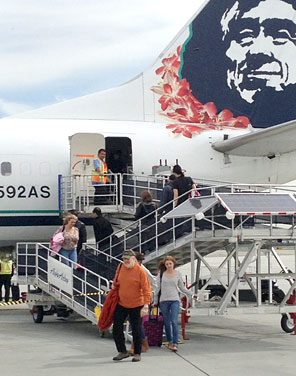The task seems straightforward enough. Get passengers from inside the terminal onto a plane quickly and efficiently so the flight can leave on time.
But if you’ve ever stood in the aisle waiting as another passenger s-l-o-w-l-y takes off a coat, fiddles around for a book and then attempts to cram an overstuffed bag into the overhead bin, you know how tedious the process can be.
Airlines would also like to hurry it up. Not just because slow boarding makes already cranky travelers even crankier but because time is money for airlines, and planes earn their keep only when they’re flying.
Most carriers now give first-class passengers and elite frequent fliers a head start down the Jetway; they then board by groups, from back to the front or from window seats toward the aisle.
In March, United Airlines created clearly marked lanes for five different boarding groups.
“We also started going to a window-middle-aisle boarding method,” said United spokesman Charles Hobart. “This reduces the interference that may occur in the aisle as a result of someone having to move to allow another customer to sit in a window or middle seat.”
On many flights, American Airlines gives early-boarding privileges to passengers who won’t be using space in the overhead bins. And Southwest Airlines, which doesn’t assign seats, “lines people up like schoolchildren and avoids the ‘mad rush’ to the door,” said a flight attendant who tweets as @PeanutsnCoke.
“By allowing people to naturally flow to the seat where they want to sit among the available options in front of them, the time savings is unmistakable,” said Southwest spokesman Brad Hawkins. “Across 3,400-plus flights each day, that saved time realizes incalculable savings not only for Southwest but for our customers. Less time to board the whole plane translates into less time sitting and awaiting departure.”
Some airlines will allow passengers to jump ahead in the boarding line for a fee. Others, like Spirit Airlines, “charge a heavy fee for carry-on luggage,” said Raymond Kollau of Airlinetrends.com. “But this seems to be an effective way to encourage passengers to check their luggage and shorten aircraft turnaround times.”
Future boarding scenarios?
In some airports in Mexico and at some smaller U.S. airports without boarding bridges, Alaska Airlines boards passengers from both the front and rear doors.
Last spring, with the help of a solar-powered boarding ramp made by Keith Consolidated Industries of Medford, Ore., the carrier began testing the use of both boarding doors on some planes at Seattle-Tacoma International Airport (its home base airport) and Mineta San Jose International Airport in California.
The motorized ramp is driven to the backdoor of the aircraft, and three switchbacks covered in a nonslip material offer a gentle slope that makes it easy to pull a rolling suitcase or push a wheelchair from the ground level to the rear door of the aircraft.
“It’s powered entirely by solar panels but can also be hitched to a tug if necessary,” said Alaska Airlines spokeswoman Marianne Lindsey.
Testing is scheduled to continue through year-end, and while the carrier isn’t shaving 10 or 15 minutes off boarding times, Lindsey said, dual-door boarding is speeding things up a bit.
“What this initiative really is about is providing our customers with a more hassle-free flying experience, i.e., saving time boarding and deplaning, which gives customers back time,” Lindsey said. “It’s also right in line with our environmental goals.”
Another option being experimented with is seats that slide out of the way.
Hank Scott, a former Australian Navy pilot who now teaches aeronautical engineering in Colorado, was sick of standing in the aisle behind people who didn’t move very quickly.
“I thought the process would go faster if I could just walk around them.”
Scott’s solution is the Side-Slip Seat, which can be moved a few inches out of the way during the boarding and deplaning process to help widen the aisles.
“We’re looking at a 50 percent improvement in the rate you can get people on an off the aircraft,” said Scott, who hopes to have the seats certified by the Federal Aviation Administration at the end of the year.
And then there’s the Jason Steffen approach.
Steffen, a Lindheimer Fellow in the physics department at Northwestern University, recommends boarding passengers in a line so that when they enter the airplane their seats are spaced two rows apart.
“For example, the first passengers would be 30A, 28A, 26A, 24A, 22A, etc. If speed is the primary goal, I believe that this method is the fastest.”
No airline has adopted the plan, but on Oct. 16, as part of a four-part PBS special called “Making More Stuff with David Pogue,” his method will be tested against that of Southwest Airlines.
“They currently have among the fastest, if not the fastest, boarding method,” Steffen said.
But perhaps not for long.
(My story ‘Airlines test new ways to board planes’ first appeared on CNBC Road Warrior)
Thanks for visiting Stuck at the Airport. Subscribe to get daily travel tidbits. And follow me on Twitter at @hbaskas and Instagram.
